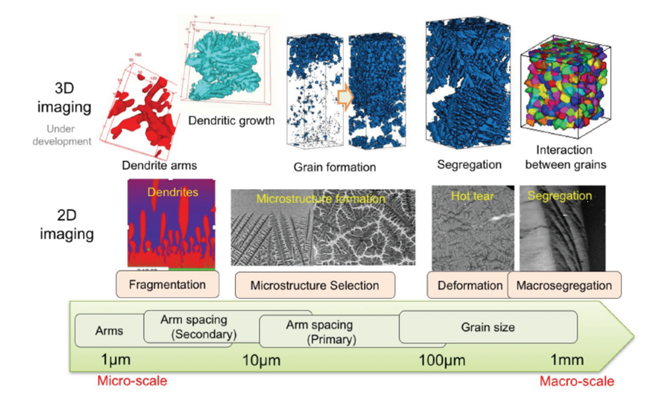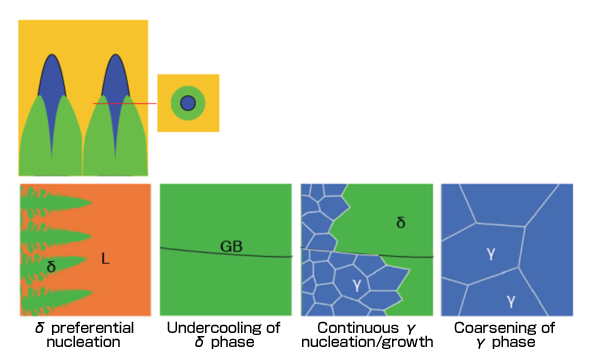 Structural materials
Investigation of Solidification Phenomena in Metallic Alloys by 2D and 3D in-situ Observation
Structural materials
Investigation of Solidification Phenomena in Metallic Alloys by 2D and 3D in-situ Observation
- Observation

-

-

-

- 2D and 3D time-resolved and in-situ observations for microstructural evolution during solidification in metallic alloys
- A massive-like transformation rather than the peritectic reaction follows the solidification in carbon steels
- The massive-like transformation proved by MD simulations and in situ time-resolved observation
A desire to directly observe the solidification phenomena at high temperatures
Solidification and casting phenomena in metals has been considered on the basis of the microstructure observations after the solidification at room temperature. Consequently, there are still ambiguities in knowing the phenomena. It has been strongly desired to observe solidification in-situ for understanding how microstructures evolve from the viewpoints of academic and industrial demands.
Dendritic growth observed at SPring-8
Monochromatized hard X-rays at SPring-8 were used to observe the solidification of metallic alloys. X-ray imaging allows us to perform the observations without any influences of radiations at high temperatures. Since difference in density between solid and liquid results in a sufficient contrast, the X-ray imaging can be used to observe solidification phenomena in most of practical alloys excluding reactive alloys such as titanium alloys.
In addition to X-ray transmission imaging, diffraction images can be obtained and provide information on crystal structures and crystallographic orientations. Deformation of semisolid at high temperatures can also be observed by introducing actuators. Elemental analysis can be performed by inserting an EDS detector. It is possible to measure solute partition between solid and liquid in multicomponent alloys such as Ni-based superalloys by the in-situ EDS analysis.
Time-resolved computed tomography (CT) also allows us to perform 3D observation of microstructure. Up to now, time-resolved 3D imaging with spatial resolutions ranging from the 1-µm to the 1-mm scale was achieved (Figure 1).
Direct observation of a new solidification mechanism (massive-like transformation)
It has been commonly considered that the peritectic reaction, in which γ (fcc) phase was produced at the interface between the δ (bcc) phase and liquid phase (top of Fig. 2), occurred during solidification of carbon steel. However, in-situ observations using synchrotron radiation X-rays at SPring-8 proved that growth of δ-phase dendrite was followed by the solid-solid transformation from the δ phase to the γ phase below the peritectic temperature (massive-like transformation).
In the phase transformation during unidirectional solidification, the massive-like transformation occurred and the γ grains coarsened. This results showed that the γ phase was produced by the massive-like transformation even during unidirectional solidification. According to the X-ray diffraction images, (110) of BCC tended to agree with (111) of FCC. It suggested that nucleation occurs in bcc and subsequently proceeds continuously at the γ phase to mitigate overall strain (Figure 2).
These observations are expected to be useful for understanding solidification phenomena and resolving industrial issues. We are currently initiating studies on how to control microstructural evolution during solidification and what crystal structures are best suited for controlling coarsening.

Figure 1 Overview of 2D and 3D time-resolved in situ observations of solidification phenomena of metallic alloys

Figure 2 A peritectic reaction according to conventional understanding of microstructural formation (top) and the massive-like transformation seen through in situ observation (bottom)

Hideyuki Yasuda
Department of Materials Science and Engineering,
Graduate School of Engineering,
Kyoto University
Research collaborators
K. Morishita (Kyoto University), and M. Yoshiya and T. Nagira (Osaka University)
References
- [1] T. Nagira et al, Metall. Mater. Trans. A, 45A (2014) 1415.
- [2] G. Zeng et al, Acta Mater. 83 (2015) 357.
- [3] K. Yamane et al, Metall. Mater. Trans. A, 46A (2015) 4937-4946.